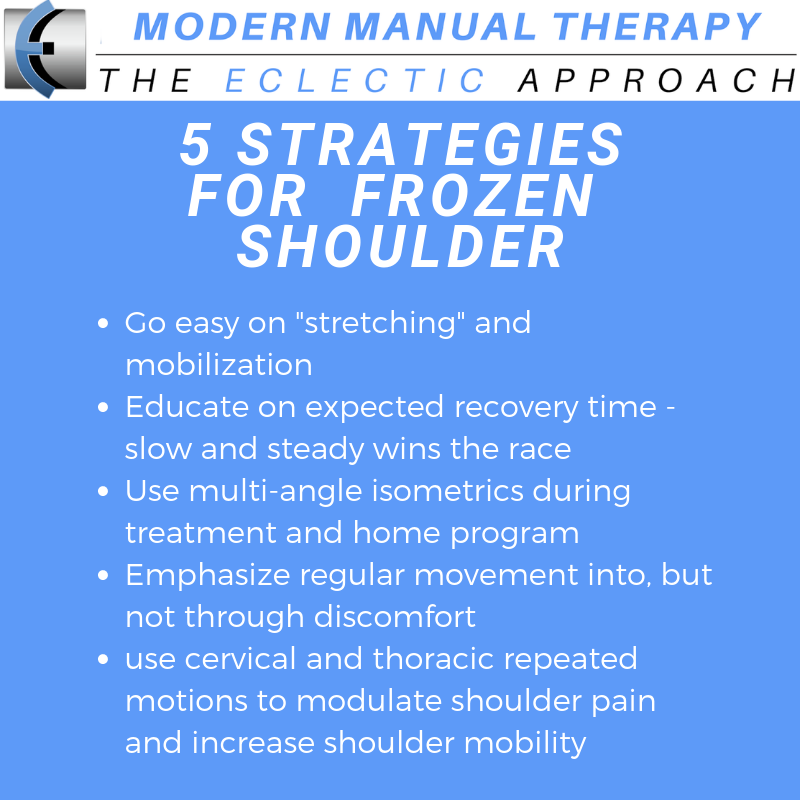Five Strategies for Addressing Patients with a Frozen Shoulder
By: Ross Cameron, MSc PT student
By: Ross Cameron, MSc PT student
Frozen shoulder poses a challenge to both therapists and patients due to its typical slow response to treatment, with gradual improvements in mobility taking months to years to occur. The associated restrictions in shoulder mobility can interfere with a patient’s daily life, causing difficulty in many everyday activities. Tasks requiring external rotation such as dressing and grooming, as well as overhead tasks, are particularly difficult. Pain and symptoms can also disturb a patient’s sleep, which can feed into a vicious cycle of increased pain perception leading to a further lack of sleep.
Strategies for Addressing a Patient Who Presents With a True Frozen Shoulder

- Go easy on stretching and mobilization
- Patients presenting with frozen shoulder may already be highly irritable and sensitive to pain – manual therapy techniques such as glides likely won’t cause any immediate improvements in mobility, but may be uncomfortable for the patient
- Every treatment, exercise, repeated loading, strengthening, manual therapy technique, etc. can be considered an input – use stretching and mobility as one tool in the toolbox
- Educate on expected recovery time
- True frozen shoulder is associated with a long recovery time, on average between 6 months and 2 years for a full recovery. It's important to keep patients motivated and encouraged
- Tissue changes, such as contracture development, have occurred in the shoulder joint, and are not quickly resolved
- No one magical technique will significantly improve function/mobility right away
- Tissue adaptation requires repeated loading over a long period of time
- Pain perception can be more quickly modulated, but mobility improvements will take time
- Use multi-angle isometrics during treatment and HEP
- Frozen shoulder involves many connective tissues in the glenohumeral joint, and multidirectional isometrics can incorporate muscles at all angles of the joint
- Frozen shoulder patients typically do not need end range loading
- Emphasize regular movement into but not through the discomfort
- The goal is to change the perception of tightness or pain, so why fight fire with fire by moving through pain?
- Repeated end range loading can be painful and discouraging if mobility improvements occur slowly
- Instead, focus on frequent movement through available pain-free range (even if the range is limited!)
- Use cervical and thoracic repeated motions to modulate shoulder pain and increase shoulder mobility
- Repeated motions are simple and easy to remember, more reliable and will have better adherence
- Everything is connected! Restricted mobility in the glenohumeral joint can affect the cervical and thoracic regions. Movement through the neck and trunk can contribute to alleviating symptoms and restoring movement in the shoulder.
Below, Dr. Religioso has shared one of his favourite techniques to start treatment on Frozen Shoulders, especially in the "capsulitis" or highly sensitized phase.
Stop Stretching Frozen Shoulders
Want to Learn More? Enhance your existing toolbox with an evidence-based framework for assessment and treatment! Modern Manual Therapy: The Eclectic Approach to Upper and Lower Quarter Assessment and Treatment is a one-of-a-kind seminar that discusses the gaps in patient engagement and treatment that are often overlooked by clinicians. Going beyond the glenohumeral joint, the course employs Dr. Religioso's comprehensive approach to assessing and treating the entire body. The course consists of over 11 hours of video lectures, recorded live demonstrations, and Q&A sessions. Click the link below to head to the course page.

DPT, FAAOMPT
Dr. Erson Religioso III, DPT, MS, MTC, CertMDT, CFC, FMS, FMT, FAAOMPT, is a fellowship trained cash based PT practice owner, entrepreneur, blogger, and sought after lecturer in the topic of Modern Manual Therapy. He has a #CashPT Practice in the Buffalo, NY area, EDGE Rehab and Sports Science, where he specializes in TMD, headaches, spinal care, runners, gymnasts, and chronic pain. His focus is seeing the patient as little as possible, and empowering them with education, self assessment and treatment strategies.
Dr. Religioso is adjunct faculty of SUNY at Buffalo, where he teaches orthopaedic manual physical therapy in the DPT program. He also developed a line of manual therapy, mobility, fitness, strength, and rehab products along with pain science education materials at The EDGE Mobility System.
Modern Manual Therapy - The Eclectic Approach is Dr. Religioso’s line of seminars for clinicians that are taught online and in live venues around the world. The Eclectic Approach started with Modern Manual Therapy, and has expanded to include Modern Strength Training, and Modern Patient Education.
Dr. E is now offering his services as both an online clinical mentor to clinicians at Modern Rehab Mastery, travelling OMPT Fellowship mentor, online patient consultations, and online business and social media consultation, #CashPT start up with LeBauer Consulting. He also is part of media company, UpDoc Media, with 2 podcasts, Therapy Insiders and Untold Physio Stories.
Erson is a family man, married to the best woman in the world, and currently has 5 beautiful children. He enjoys running with them, watching them in competitive gymnastics and watching Disney/Pixar movies. He is also a huge tech geek and loves all things Marvel, Star Wars, and Star Trek. If you see Dr. E out and about, or at a seminar, ask him to grab a beer or coffee and talk about shop or anything!